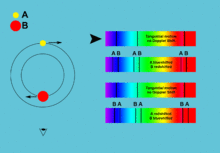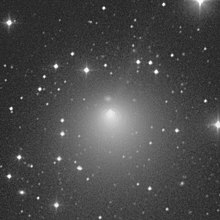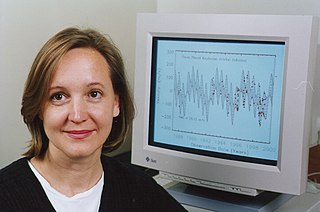
Debra Ann Fischer is an American astronomer who is the Eugene Higgins professor of astronomy at Yale University researching detection and characterization of exoplanets. She has detected hundreds of exoplanets and was part of the team to discover the first known multiple-planet system.
Gliese 710, or HIP 89825, is an orange 0.6 M☉ star in the constellation Serpens Cauda. It is projected to pass near the Sun in about 1.29 million years at a predicted minimum distance of 0.051 parsecs—0.1663 light-years – about 1/25th of the current distance to Proxima Centauri. Such a distance would make for a similar brightness to the brightest planets, optimally reaching an apparent visual magnitude of about −2.7. The star's proper motion will peak around one arcminute per year, a rate of apparent motion that would be noticeable over a human lifespan. This is a timeframe, based on data from Gaia DR3, well within the parameters of current models which cover the next 15 million years.
HD 177830 is a 7th magnitude binary star system located approximately 205 light-years away in the constellation of Lyra. The primary star is slightly more massive than the Sun, but cooler being a type K star. Therefore, it is a subgiant clearly more evolved than the Sun. In visual light it is four times brighter than the Sun, but because of its distance, about 204 light years, it is not visible to the unaided eye. With binoculars it should be easily visible.
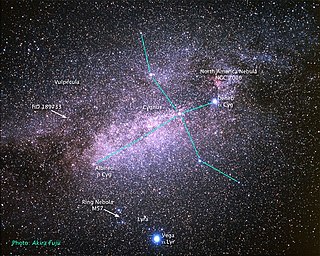
HD 189733, also catalogued as V452 Vulpeculae, is a binary star system 64.5 light-years away in the constellation of Vulpecula. The primary star is suspected to be an orange dwarf star, while the secondary star is a red dwarf star. Given that this system has the same visual magnitude as HD 209458, it promises much for the study of close transiting extrasolar planets. The star can be found with binoculars 0.3 degrees east of the Dumbbell Nebula (M27).

A sub-brown dwarf or planetary-mass brown dwarf is an astronomical object that formed in the same manner as stars and brown dwarfs but that has a planetary mass, therefore by definition below the limiting mass for thermonuclear fusion of deuterium . Some researchers call them rogue planets whereas others call them planetary-mass brown dwarfs.

HD 136118 is a star in the Serpens Caput section of the Serpens constellation. The star is too dim to be readily visible to the naked eye, having an apparent visual magnitude of 6.93. It is located at a distance of 165 light years from the Sun based on parallax, and is drifting closer with a radial velocity of −3 km/s.
HD 68988 is a star in the northern constellation of Ursa Major. It has been given the proper name Násti, which means star in the Northern Sami language. The name was selected in the NameExoWorlds campaign by Norway, during the 100th anniversary of the IAU. HD 68988 is too faint to be seen with the naked eye, having an apparent visual magnitude of 8.20. The star is located at a distance of 199 light years from the Sun based on parallax. It is drifting closer with a radial velocity of −69 km/s and is predicted to come as close as 78 light-years in 617,000 years.
HD 106252 is a star with a brown dwarf companion in the constellation Virgo. An apparent visual magnitude of 7.41 means this star is too faint to be visible to the naked eye. It is located at a distance of 210 light years from the Sun based on parallax measurements, and is receding with a radial velocity of 15 km/s.
HD 141937 is a star in the southern zodiac constellation of Libra, positioned a couple of degrees to the north of Lambda Librae. It is a yellow-hued star with an apparent visual magnitude of 7.25, which means it is too faint to be seen with the naked eye. This object is located at a distance of 108.9 light years from the Sun based on parallax, but is drifting closer with a radial velocity of −2.2 km/s. It has an absolute magnitude of 4.71.
Gliese 179 is a small red dwarf star with an exoplanetary companion in the equatorial constellation of Orion. It is much too faint to be visible to the naked eye with an apparent visual magnitude of 11.94. The system is located at a distance of 40.5 light-years from the Sun based on parallax measurements, but is drifting closer with a radial velocity of –9 km/s. It is a high proper motion star, traversing the celestial sphere at an angular rate of 0.370″·yr−1.
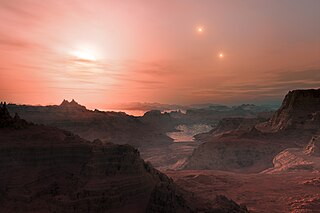
Gliese 667 Cc is an exoplanet orbiting within the habitable zone of the red dwarf star Gliese 667 C, which is a member of the Gliese 667 triple star system, approximately 23.62 light-years away in the constellation of Scorpius. The exoplanet was found by using the radial velocity method, from radial-velocity measurements via observation of Doppler shifts in the spectrum of the planet's parent star.
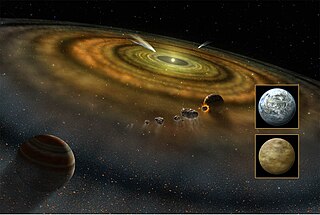
An exocomet, or extrasolar comet, is a comet outside the Solar System, which includes rogue comets and comets that orbit stars other than the Sun. The first exocomets were detected in 1987 around Beta Pictoris, a very young A-type main-sequence star. There are now a total of 27 stars around which exocomets have been observed or suspected.

HD 131399 is a star system in the constellation of Centaurus. Based on the system's electromagnetic spectrum, it is located around 350 light-years away. The total apparent magnitude is 7.07, but because of interstellar dust between it and the Earth, it appears 0.22 ± 0.09 magnitudes dimmer than it should be.

A circumplanetary disk is a torus, pancake or ring-shaped accumulation of matter composed of gas, dust, planetesimals, asteroids or collision fragments in orbit around a planet. They are reservoirs of material out of which moons may form. Such a disk can manifest itself in various ways.



